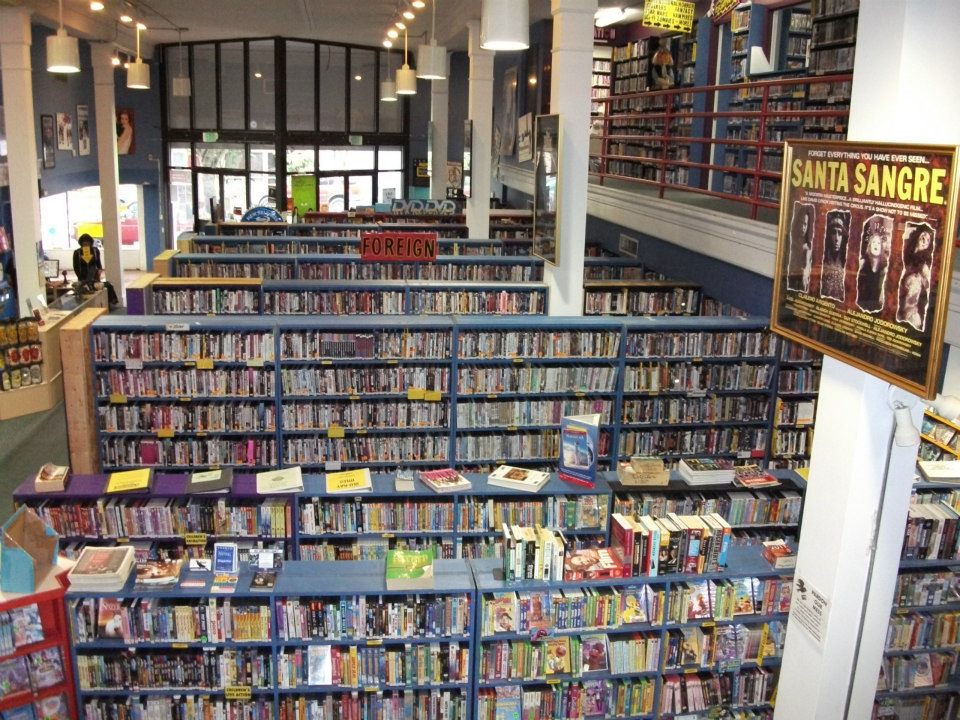The announcement that Blockbuster, once the King Kong of video rentals with 9000 locations around the world, is shutting down the last of its 300 corporate stores and its rent-by-mail business confirmed what we’ve been seeing happen in the last few years: we’re losing the video store culture to the new streaming paradigm.
But it isn’t the chain-store culture of Blockbuster that is real loss, mind you. It’s the independent alternatives that made an effort to search out classics and foreign films and cult movies that couldn’t be found on the shelves of corporate chains. It was a film school to many of us, from filmmakers to film critics to historians, and it continues to preserve a culture of access of movies that streaming video can’t provide. The end of physical media rentals may be inevitable but there’s no reason that it has to happen now, not in communities with a strong commitment to film culture.
Cinephiled has come not to bury the video store but to praise the best of them. And we begin with the greatest video store of them all …
 On Friday, December 6, 2013, Seattle’s Scarecrow Video celebrated its 25th Anniversary.
On Friday, December 6, 2013, Seattle’s Scarecrow Video celebrated its 25th Anniversary.
It’s been called the greatest video store in the country. Bernardo Bertolucci not only frequented the store while shooting Little Buddha in Seattle, he praised the store and its cinema treasures to a sold-out audience at the film’s Seattle premiere. Bertrand Tavernier explored the entire laserdisc section and gushed over the selection of Cy Enfield and William Whitney tapes with store employees in his 1997 visit. Quentin Tarantino, a video store veteran in his own right, paid tribute by walking from downtown Seattle to the store’s University District location: his personal pilgrimage to the video Mecca.
And in addition to stocking a magnificently curated rental library of movies on home video, Scarecrow in its heyday brought such guests as Wim Wenders, Werner Herzog, John Woo, Monte Hellman, Nicolas Roeg and Seijun Suzuki to Seattle for glorious retrospectives.
In some ways, it is a small miracle that the store even exists today. Its founder and original owner George Latsios, who opened the first incarnation in 1988 with a couple of hundred videotapes, many of them oddball cult titles, maintained a precarious balancing act through the nineties as he aggressively funneled profits back into the inventory, growing the store at a furious rate, while battling brain cancer. He almost lost the store to bankruptcy in the process. (Latsios died of cancer in 2003.)
A proposed sale to one prospective buyer with grand plans for expansion became mired in controversy and legal fights that left the store hanging by a thread. Carl Tostevin and John Dauphiny, Microsoft engineers and devoted Scarecrow customers, stepped in to purchase the store in 1998 and Tostevin bought out his partner a few years later, carrying the store up through the heights of the DVD boom of the early 2000s and keeping it alive during the financial squeeze of streaming video with the help of a dedicated staff, many of whom have been with the store for more than a decade and some who have seen the store through nearly 20 years.
That Scarecrow Video, my pick for the greatest video store in the known universe, still stocks close to 120,000 movie and TV titles, including import DVD and Blu-ray releases and rarities on VHS and laserdisc not yet on disc, is cause to celebrate.
It’s also MY video store. Yes, for three years in the nineties I was a manager in the store’s inventory office, but that’s not why I claim this video Valhalla. In the early nineties, long before I moved to Seattle, I drove up from Eugene to visit friends and I always brought my laserdisc player and a VCR so I could dub Hong Kong laserdisc imports to watch back home. When I worked at Scarecrow, I treated myself to mini-festivals throughout the year, investigating favorite directors, catching up with rare film noirs and Italian horror movies, and keeping current with new international cinema. I saw the original Ringu on a Japanese VCD (the pre-DVD format!) and, long before Yi Yi made his name in the U.S., Edward Yang’s first movies from laserdisc import. After I left to pursue a career in film writing, Scarecrow remained my reliable—my essential—research library. When I had the opportunity to interview Miike Takashi and Johnnie To, I crammed by renting their films from Scarecrow. Who else would have stocked their filmographies so determinedly?
It’s still the only place I go to rent, whether it’s pleasure viewing or research for an article or review. Sometimes, I just stop by to browse the rental shelves to see what imports they have just acquired, what domestic glories they have brought in for their small but smartly-curated sales rack and what goodies line the used shelves. Just to be in the company of these discs, chatting with the clerks and managers about what they’ve been seeing, lifts my spirits and opens my horizons. Metrics and logarithms don’t replace the conversations that lead to new discoveries and make loyal customers, they merely offer a pale substitute, and there are so many great and interesting films that you can’t get on Netflix or Amazon Instant. I don’t want to lose that access or that atmosphere.
Scarecrow posted an open letter to customers on their website in advance of International Independent Video Store Day (which, if your calendar fails to list it, was October 19) and local media responded with articles, news stories and profiles. It’s helped encourage a boost in rentals and sales and the anniversary celebration has continued that attention. But it needs to be sustained by the community if it’s to survive.
For more information on how Scarecrow and other video meccas in the U.S. are surviving the challenges of the streaming age, see my article at Indiewire.


